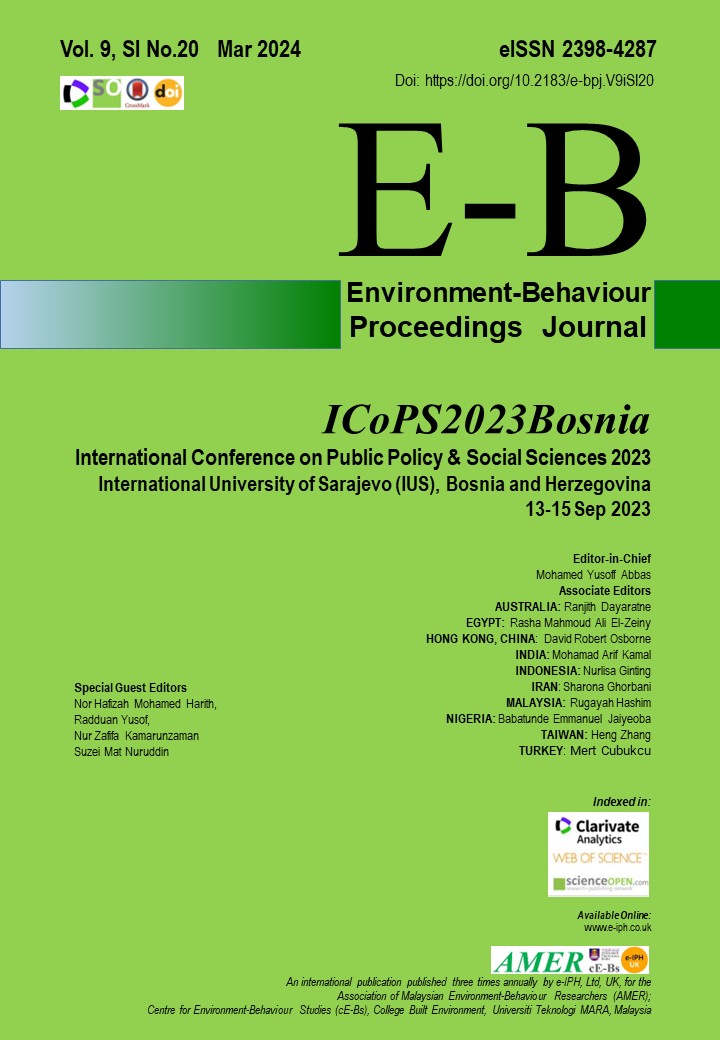Role of Social Demography Factors in Economic Growth and Sustainability Models: Evidence from selected emerging economies
DOI:
https://doi.org/10.21834/e-bpj.v9iSI22.5896Keywords:
Economic Growth, Sustainable Development, Emerging EconomiesAbstract
A country’s social demography characteristics are described by population dynamics and technology-based lifestyle changes. Such unique elements may correlate with economic growth and sustainability. In this study, a static panel data model analysis for economic growth and sustainable development of ten emerging economies was presented. Estimation results revealed that social demography factors exhibited a negative significant impact in both economic models, relative to the technological influence. Therefore, effective macroeconomic policies should be meticulously designed against changing demographic trends. Conclusively, by delivering focused public services to the urban area, more liveable cities will emerge to empower human capital development.
References
Afroz, R., Muhibbullah, M., & Morshed, M. N. (2020). Impact of information and communication technology on economic growth and population health in Malaysia. The Journal of Asian Finance, Economics and Business, 7(4), 155-162. DOI: https://doi.org/10.13106/jafeb.2020.vol7.no4.155
Awad, A. (2023). Do ICT and economic globalisation offer benefits to all nations? Findings from a moments quantile regression. Environment, Development and Sustainability, 1-25. DOI: https://doi.org/10.1007/s10668-023-02938-2
Bairoliya, N., & Miller, R. (2021). Demographic transition, human capital and economic growth in China. Journal of Economic Dynamics and Control, 127, 104117. DOI: https://doi.org/10.1016/j.jedc.2021.104117
Bloom, D. E., Canning, D., Fink, G., & Finlay, J. E. (2010). The cost of low fertility in Europe. European Journal of Population/Revue Européenne de Démographie, 26(2), 141-158. DOI: https://doi.org/10.1007/s10680-009-9182-1
Bolt, K., Matete, M., & Clemens, M. (2002). Manual for Calculating Adjusted Net Savings. http://siteresources.worldbank.org/INTEEI/1105643-1115814965717/20486606/Savingsmanual2002.pdf
Brundtland, G., Khalid, M., Agnelli, S., Al-Athel, S., Chidzero, B., Fadika, L., Hauff, V., Lang, I., Shijun, M., & de Botero, M. M. (1987). Our common future (Brundtland Report). In.
Chissom, B. S. (1970). Interpretation of the kurtosis statistic. The American Statistician, 24(4), 19-22. DOI: https://doi.org/10.1080/00031305.1970.10477202
Ferreira, S., & Vincent, J. R. (2005). Genuine savings: a leading indicator of sustainable development? Economic Development and Cultural Change, 53, 737-754. http://dx.doi.org/10.1086/426834 DOI: https://doi.org/10.1086/426834
Frick, S. A., & Rodríguez‐Pose, A. (2018). Big or small cities? On city size and economic growth. Growth and Change, 49(1), 4-32. DOI: https://doi.org/10.1111/grow.12232
George, D., & Mallery, P. (2018). Descriptive statistics. In IBM SPSS Statistics 25 Step by Step (pp. 126-134). Routledge. DOI: https://doi.org/10.4324/9781351033909-14
Gori, L., & Sodini, M. (2021). A contribution to the theory of fertility and economic development. Macroeconomic Dynamics, 25(3), 753-775. DOI: https://doi.org/10.1017/S1365100519000415
Gujarati, D. N. (1995). Basic Econometric (3rd ed.). McGraw-Hill Inc.
Hausman, J. A. (1978). Specification tests in econometrics. Econometrica: Journal of the econometric society, 1251-1271. DOI: https://doi.org/10.2307/1913827
Henderson, J. V. (2000). The effects of urban concentration on economic growth. In: National bureau of economic research Cambridge, Mass., USA. DOI: https://doi.org/10.3386/w7503
Hess, P. (2010). Determinants of the adjusted net saving rate in developing economies. International Review of Applied Economics, 24, 591-608. DOI: https://doi.org/10.1080/02692170903426070
İmrohoroğlu, A., & Zhao, K. (2018). The chinese saving rate: Long-term care risks, family insurance, and demographics. Journal of Monetary Economics, 96, 33-52. DOI: https://doi.org/10.1016/j.jmoneco.2018.03.001
Kazemzadeh, E., Fuinhas, J. A., Salehnia, N., & Osmani, F. (2023). The effect of economic complexity, fertility rate, and information and communication technology on ecological footprint in the emerging economies: A two-step stirpat model and panel quantile regression. Quality & Quantity, 57(1), 737-763. DOI: https://doi.org/10.1007/s11135-022-01373-1
Nguyen, H. M. (2018). The relationship between urbanization and economic growth: An empirical study on ASEAN countries. International Journal of Social Economics. DOI: https://doi.org/10.1108/IJSE-12-2016-0358
Ramasubramanian, G., Shaikh, A. A., & Sharma, R. (2021). Examining the Impact of ICT on Sustainable Development: A Data-Driven Narrative. Proceedings of the Annual Hawaii International Conference on System Sciences. DOI: https://doi.org/10.24251/HICSS.2021.534
Ridzuan, A. R., Khalid, M. W., Zarin, N. I., Razak, M. I. M., Ridzuan, A. R., Ismail, I., & Norizan, N. (2018). The impact of foreign direct investment, domestic investment, trade openness and population on economic growth: evidence from ASEAN-5 countries. International Journal of Academic Research in Business and Social Sciences, 8(1), 128-143. DOI: https://doi.org/10.6007/IJARBSS/v8-i1/3799
Sharma, G. D., Rahman, M. M., Jain, M., & Chopra, R. (2021). Nexus between energy consumption, information and communications technology, and economic growth: an enquiry into emerging Asian countries. Journal of Public Affairs, 21(2), e2172. DOI: https://doi.org/10.1002/pa.2172
Solow, R. M. (1974). Intergenerational Equity and Exhaustible Resources. The Review of Economic Studies, 41, 29-45. http://folk.uio.no/gasheim/zSol1974.pdf DOI: https://doi.org/10.2307/2296370
Wald, A. (1943). Tests of statistical hypotheses concerning several parameters when the number of observations is large. Transactions of the American Mathematical society, 54(3), 426-482. DOI: https://doi.org/10.1090/S0002-9947-1943-0012401-3
Wooldridge, J. M. (2015). Introductory econometrics: A modern approach. Nelson Education.
Yang, J. (2023). Fertility Policy and Social Change in China. In Social Inequality in China (pp. 369-396). DOI: https://doi.org/10.1142/9781800612143_0015
Downloads
Published
How to Cite
Issue
Section
License
Copyright (c) 2024 Faridah Pardi, Mohammad Yuzaimi Yasin, Nur Fadhlina Zainal Abedin, Sutina Junos

This work is licensed under a Creative Commons Attribution-NonCommercial-NoDerivatives 4.0 International License.





